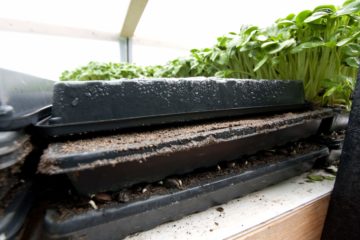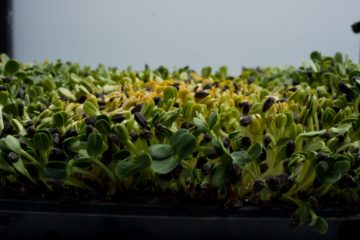One of the main goals of microgreens crop planning is to ensure you have enough Crop to meet your Product needs, but not so much that you end up with waste. Now, of course any extra microgreens Crop you produce can be taken home or used for samples, but such Crop “extras” can, and should, be taken into account with crop planning. That way you can ensure have an intended purpose for all the Crops you sow.
With good crop planning you can very accurately calculate your Crop needs to meet your Orders. But crop planning is only perfect in a perfect world – and that is not the world in which we live. So we must account for discrepancies in how much crop we sow vs how much crop we need. Two ways we can do this is with Order “buffers” and through Product reallocation.
Buffers
A buffer is an extra amount of crop you sow to ensure you have enough product to meet your Order needs. But, of course, we don’t want to sow so much extra that we end up with crops that could potentially go to waste, so you will want to be careful with your Crop buffers as well.
There are two basic situations in which we account for with Crop buffers:
- Lower-than-expected crop yield
- This happens more often for newer growers but can also occur due to unexpected changes in your growing conditions which reduce crop yields
- New orders
- Crop planning only allows us to accurately account for confirmed or expected orders; new orders can easily throw off our Crop planning efforts
Let’s look at two easy ways to create crop buffers, or extra crop.
- Rounding up
- The easiest way to create a Crop buffer is to round up the calculated number of trays you need to sow. In fact, you must round your Crop sowing up to the nearest tray to ensure you have enough Crop to meet your Order needs. If your crop planning determines you need 7.3 trays of sunflower to fulfill your Orders, seven trays won’t do it – you must sow eight trays.
- The above example rounds up to the nearest tray, but you can also round up to the nearest “multiple” of trays. For example, rounding up to the nearest multiple of two or three trays. This is a little less consistent in terms of how much buffer crop you end up with, but can be useful for larger volumes of trays to ensure consistent germination layout. The Food Pedalers always rounded up their trays to the nearest multiple of three, because we stacked our trays in threes for germination. Always having a multiple of three for our number of trays helped keep us more organized during the germination phase of production.
- Virtual Customers
- You can also have a buffer by creating an Order for a “virtual” customer – or, sowing a specific number of buffer trays for each Crop based on a Customer that does not necessarily exist. From another perspective, you can say are sowing a number of trays for your own farm, that you can allocate to new Orders or use for yield shortfalls as needed. The reason I use the term “Virtual Customer” is because the idea does not just apply to buffer Crops, it can also be used for samples, displays, and staff Orders.
Product Reallocation
The above two examples are strategies to produce extra Crop if needed. But sometimes, even with extra Crop, you don’t have enough Crop to meet your Orders. Then what do you do? In this case, we use a “Product reallocation” strategy. Product reallocation does not necessarily increase your sales but can help ensure that you don’t lose a sale. In short, you take a little bit of Product from several Customers to make up an Order for another Customer – often a new customer. This ensures everybody gets at least something when you have a crop shortfall.
This can be an effective strategy for several reasons:
- It helps ensure you can fulfill your Orders, even if it means some Orders are reduced. This is important for providing consistent and reliable service to your Customers.
- It can make your Orders more accurate. When deciding which Orders to reallocate Products from, you can target Customers that might have more Product than they can use, and ensure they are making the best use of the Product they have. This is something you will often have a sense of from your previous deliveries and is much easier if you do multiple deliveries each week. You can reach out to specific Customers and simply ask them if you can reduce their Order to help fulfill other Orders. If you know your Customers well, this should be an easy task – and Customers often appreciate the fact they now don’t have to buy Product they may not be able to use
A great natural buffer for Customers’ Orders is your farmers market stock. If you do sales to both retail Customers and attend farmers markets, you can always borrow from market stock to meet your retail Customer needs. In many cases we want to avoid this because the farmers market can often be your your highest-value sales. But farmers markets are only expected sales, whereas your retail Customers, at least on delivery day, are confirmed sales.
The farmers market buffer strategy can be good from two perspectives:
- As stated above, farmers markets are only expected sales, and it is generally a good idea to favour confirmed sales over expected sales to avoid a lost sale.
- Farmers market sales suffer from poor weather, so if you see poor weather in the forecast, you can try and sell some of your farmers market stock to your retail Customers, again – getting in touch with them to see which Customers can best use the Product.
Product reallocation is generally much easier at a larger scale of production than at a smaller scale, as you will have more customers to work with and reallocate Orders to and from.
SeedLeaf uses both the “round up” and buffer Customer strategies to plan your Crops and give you some flexibility in how much buffer Crop you sow for each harvest.



0 Comments